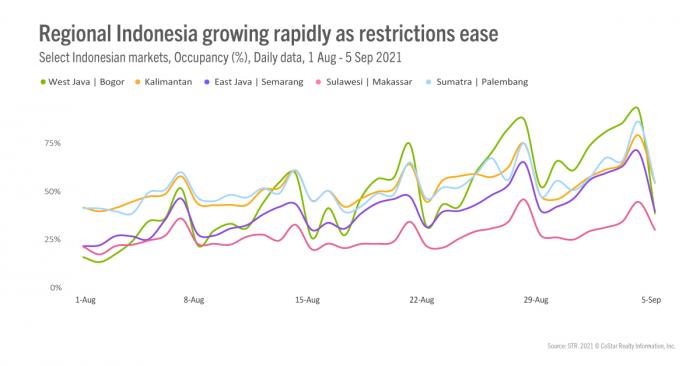While vaccination rates grow rapidly, case numbers fall, and hospital beds are more available, Indonesians are once again hitting the road and creating hotel demand around the country. The business community has played a role in increasing the vaccine rate, and while schools remain mostly virtual but on the way to reopening for in-person learning, strict lockdowns have been lifted, government business is back with 50% capacity for meetings, and people are venturing out more and more each week. A vaccine certificate is officially required when using public transport and entering restaurants, malls and even some office buildings, but the risk for a third wave remains. The hope is that vaccinations and testing protocols will prevail on the road ahead.
Many stakeholders, and far from just in the hospitality sector, also received a boost last week, as financial support was extended until March 2023 via the continued relaxation of banking rules that make it easier for Indonesian borrowers to restructure loans.
This relaxation limits the control mechanism for the time frame in which lenders can expect payment, rather than the full scope of overall financial implications. Alongside new liquidity inserted into the economy and interest rate cuts, we expect government support to continue through the end of the crisis.
As a result of the relaxed banking rules, we also continue to expect limited distressed assets in the hospitality sector, as local banks follow through and broadly ease the pressure on lenders and borrowers. Many new projects remain on hold with delays in the pipeline, but when compared to the rest of Southeast Asia, there are few Indonesian properties closed at the moment.
Increased travel
In the highly populated capital of Jakarta, with its high vaccination rates, people are heading out for weekend breaks, and it's not a coincidence that much of this is done driving on some of the new toll roads, as travelers can skip the more expensive PCR test and rely on the more affordable Rapid Antigen test (the price of which was updated last week). Once the Rapid Antigen test is the method used for air travel, we expect that travel route to increase as well.
Hotel performance showing how quickly it shifts
While Central Jakarta remains somewhat muted outside of quarantine business, and while the overall office rental market has dropped significantly with many working from home, we expect further demand shifts across greater Jakarta whereas currently the southern and eastern parts are seeing an uplift.
Western Java, which we know as Bogor and Bandung, along with the Banten area, has continued to be popular for the Jakarta exodus – well above the demand increase west of Jakarta in Tangerang. Short distance and good lodging options have made many drive south or west so far.
